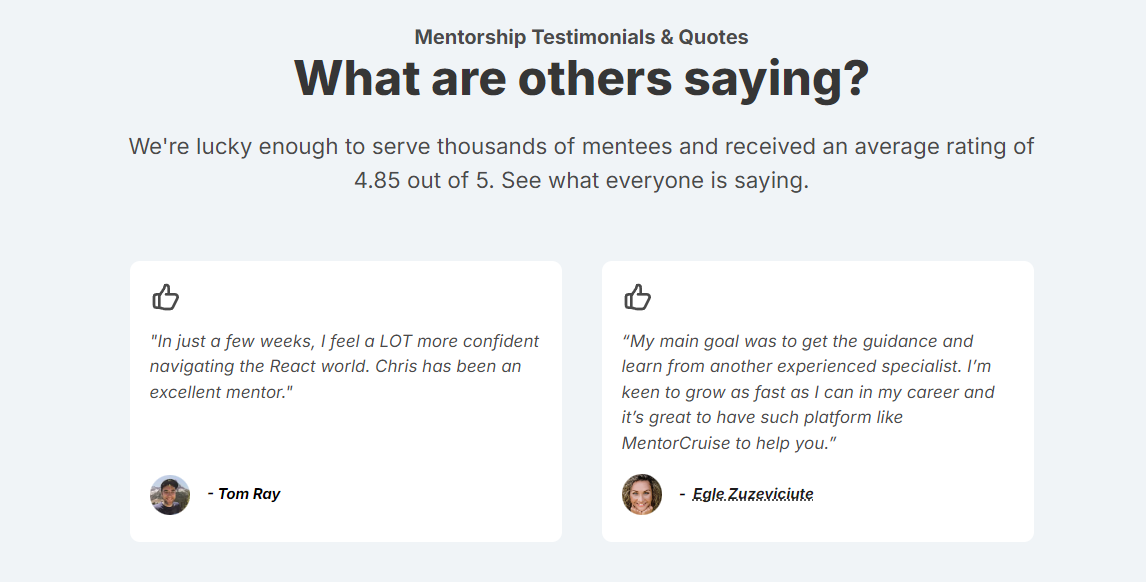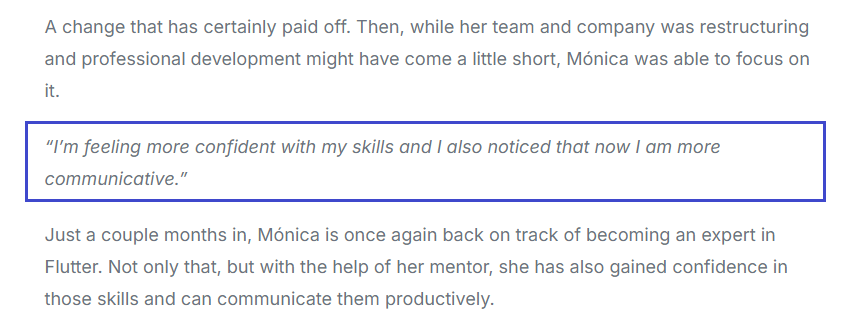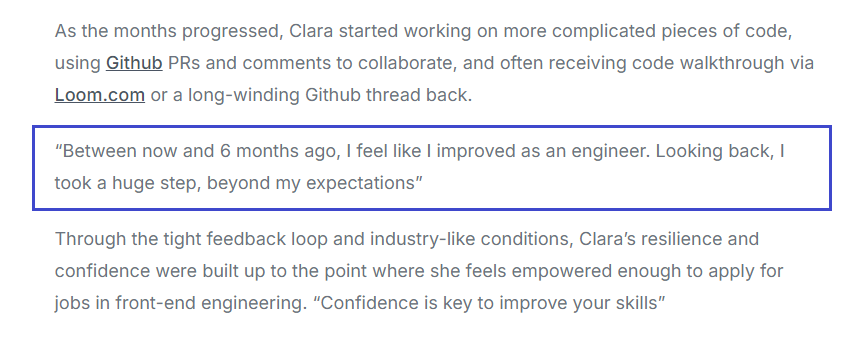Your team’s ability to adapt, grow, and stay competitive will be the determining factor in taking your business to the next level.
Therefore, providing your employees with training programs will go a long way to molding your employees into the dream team you need to start dominating your industry.
So in this MentorCruise guide, we will share 10 different employee training programs that can help boost your workplace performance and unlock the full potential of your employees.
Our mentorship program here at MentorCruise has been instrumental to many companies in helping their employees become more effective and efficient in performing their duties.
Take for instance the case of how Egle found the confidence and developed the skills for her new role in the company. Or the case of how Peyton used our mentorship platform to transform himself into a talented Full-Stack Developer.
And it doesn’t end there! We have plenty of other case studies demonstrating how our platform can positively impact the careers of professionals across different industries.
Our testimonials speak for themselves!

Employee training programs are activities that provide professionals with new knowledge, skills, and abilities needed to perform their job duties more effectively.
There are many kinds of employee training, including mentorship, formal classroom-style training, on-the-job training, workshops, seminars, online courses, and more.
By providing your team with regular training, you as an employer empower them to become more efficient, productive, and effective in their work.
Employee training goes beyond enhancing your team’s individual working capabilities; it provides your business with security, stability, and adaptability.
Here's a detailed look at the importance of employee training for your business:
As industries evolve, new technologies and methodologies emerge. This creates a gap between current employee skills and those needed for future success.
Hence, providing your workforce with training helps bridge this gap, ensuring that they remain competent and can continuously carry out their duties effectively.
A good example would be the case of Monica and how going through personal training helped her acquire the necessary skills to perform her duty at Flutter.

Besides addressing skill gaps, employee training programs equip your workforce with the latest skills and knowledge necessary to perform their roles effectively.
With proper training, your team is more likely to perform their tasks with efficiency and competence, which can only be good for your company and business.
Training ensures that your employees have a consistent understanding of your company’s policies and procedures. This trait is critical for maintaining quality standards and operational efficiencies.
To draw an analogy, it’s the same as how restaurant owners ensure all their chefs are trained on the exact recipes and presentation styles to maintain consistent food quality and customer experience.
The same thing is true for professionals working in different industries.
When employees are properly trained, the likelihood of workplace accidents, legal issues, and injuries will be significantly reduced.
This is particularly true in industries like healthcare, construction, and manufacturing where ongoing training is crucial to ensure that work is performed safely and in compliance with legal and regulatory requirements.
There are many types of employee training programs, each suited to different needs, learning styles, and strategic goals.
Here are some of the most effective types of training that can help your employees perform their duties at the highest level.
Mentorship is a professional relationship in which a more experienced or knowledgeable person (the mentor) provides guidance, advice, and support to a less experienced person (the mentee).
There are two types of mentorship, internal and external. Let’s take a look at both of them.
This employee training approach involves a learning activity between a more experienced employee within your organization and a newcomer.
In this setup, the mentor (a veteran in your organization) helps the mentee (you) learn new skills, handle problems, and move forward in their career.
The mentor shares their own experiences to give advice and feedback, which helps the mentee grow in their job and as a person
In an external mentorship, professionals find mentorship outside their organization or company for new knowledge, unbiased insights, and new learning opportunities.
External mentorship programs can be particularly beneficial for professionals looking to gain insights from different industries or fields.
Moreover, external mentorship allows one to expand their network, seek guidance on personal development goals, explore new ideas, challenge their assumptions, and broaden their horizons.
External mentors can be found through networking events, professional associations, alumni networks, social media, personal connections, and online platforms such as MentorCruise.
MentorCruise is an online platform offering personalized mentorship programs that help professionals unlock their full potential. Here's how MentorCruise can benefit your employees:
MentorCruise's personalized approach and industry-expert mentors make it a valuable resource for employers seeking to keep their workforce sharp and competitive.
Take Clara for example. After following a mentorship program at MentorCruise, she was able to overcome the challenges in her current role and perform her work duties more effectively than before.

And guess what? Clara is just one of the many professionals who shared their real-life success stories after partnering with our mentors.
On-the-job training is often conducted during regular working hours where new employees learn the ropes by performing the tasks on the spot.
For example, let’s assume your business is in retail.
While on-the-job training, you might assign a new employee to shadow a colleague and take notes on the tasks they do and how they do it.
Then, you can proceed by giving the said employee more responsibilities along the way until they can manage to complete the tasks without any supervision from you or their seniors.
E-learning, short for electronic learning, is the use of electronic gadgets and technologies for professionals to gain new knowledge or skills.
E-learning can take many forms, including taking an online course, joining a virtual classroom, studying with multimedia presentations, or enrolling in an online mentorship program like MentorCruise.
One of the upsides of e-learning is it offers your employees the flexibility and convenience to study and learn how to remain effective at performing their work duties at their own pace from anywhere with an internet connection.
Workshops and seminars are both short-term training events that focus on helping your employees learn new specific skills or knowledge. Similar to mentorship, workshops, and seminars are often led by professional veterans and experts.
In a workshop, your employees will engage in an interactive learning environment through hands-on activities, group discussions, and practical exercises. Workshop activities are designed to help professionals acquire new skills, deepen their understanding of a subject, or solve specific problems.
Workshops often encourage collaboration and active participation, allowing you to learn from both the event facilitator and your colleagues.
However, unlike external mentorship and e-learning, workshops are less flexible when it comes to scheduling and location as they are often conducted on specific dates and venues.
Seminars, unlike workshops, are more formal presentations or lectures led by experts in a particular field. You should leverage them to provide your workforce with in-depth information and insights on specific topics, often with research findings, case studies, and best practices.
In some cases, seminars may also include interactive elements such as Q&A sessions or panel discussions to engage and encourage dialogues.
This employee training method uses realistic scenarios and simulations that require your employees to think and react as they would in actual situations.
Role-playing and simulation are particularly effective for skills such as negotiation, sales, customer service, and management training.
For example, healthcare provider employees could participate in simulation training for nurses to practice emergency care procedures in a controlled, but lifelike, setting.
Cross-training involves training employees of a particular department in the roles and responsibilities of their colleagues. The goal of this activity is to promote versatility and flexibility within a team.
For instance, if you have an employee working as a machine operator in your company, you can make them undergo cross-training where they learn how to operate different types of machinery than what they are normally assigned.
This training helps reduce downtime to allow for seamless transitions in times of employee absence.
At MentorCruise, we offer personalized mentorship programs that could potentially be used in cross-training initiatives to provide your team with guidance and support from experienced professionals outside their immediate team or department.
A good example would be that of Peyton and how his mentor has helped him evolve into a talented Full-Stack Developer.
Conferences and other professional development events can provide your employees with much-needed exposure to new skills, ideas, trends, and technologies that can be useful in performing their roles more efficiently.
Conferences also give your employees a chance to network, explore exhibits, and discover new industry trends and research relevant to their profession.
This training method empowers your team to take charge of their own training and learning process on how to become more effective at work.
As a real-life example, Aziz Mamatov, one of our mentors at MentroCruise shares his experience of how through self-directed learning he was able to secure roles at prominent companies like Meta and eBay.
Gamification is a fun training method for employees as it makes the learning experience more engaging and interactive.
This employee training approach uses points, leaderboards, achievement badges, and challenges to motivate individuals and make their learning process fun and competitive.
For instance, your customer service department might use a gamified platform where each member will earn badges and points for completing training modules on conflict resolution and advanced communication skills.
This type of training program encourages collaborative learning and idea generation, allowing your employees to learn from their colleagues' experiences and perspectives. It's particularly useful for solving complex problems and generating new ideas.
To accomplish this, you can encourage your employees to:
For example, your tech company might hold monthly group discussion sessions where software developers discuss emerging technologies and propose innovative features for upcoming projects.
To make the most of your employee training programs, consider the following tips:
Start by clarifying the specific objectives of each training program and how they align with each of your employee’s development goals.
For example, if your goal is to improve your team’s project management skills, recommend that they choose a training program for mastering specific project management tools or techniques relevant to their roles.
In this case, a mentorship program would be a great choice. Online platforms like MentorCruise can provide your employees with a training platform that meets their specific needs.
Assessing the relevance of each training program to your employee’s current role or future career aspirations is essential.
This will ensure they will invest their time and effort in training programs that offer the most value to their career and their roles in your company.
Consider the case of Samantha and her experience at MentorCruise as she transitioned to a career in data analytics from audio engineering.
The impact of personalized mentorship. With guidance from Leoson Hoay, she developed essential technical skills and overcame internal barriers. It goes to show that any employee can upskill no matter what hurdles they face.

Consider each employee’s preferred learning style and how well it aligns with the training program format that you recommend for them.
Take note if an employee learns best through hands-on activities, group discussions, or individual study. Everyone absorbs information in their own unique way.
For example, if someone is a hands-on learner, they may benefit most from a training program that includes interactive or practical exercises like personal mentorship.
On the other hand, if someone prefers group discussions, he or she may thrive in a program that includes collaborative projects or group activities like seminars and conferences.
Let’s face it, unlocking your workforce’s full potential will require a substantial investment on your part. That’s why you need to take a moment to evaluate the cost of the different training programs you want to provide for your employees and ensure that it is within your company’s budget.
Furthermore, make the program accessible so that your employees can fully engage with the material without financial or logistical barriers. If you need to run the program remotely, so be it.
Timing the programs right is an underrated factor in its success.
Accept the fact that your employees have a life outside work and that you must respect that space. You don’t want to infringe on their downtime.
Hence, take the time to ask your employees for the best training program that will fit their daily schedules.
Keep in mind that a training program can only be truly effective if your employee can dedicate the necessary time and effort to participate fully in each program, thus giving the training the attention it deserves.
Speaking of which, MentorCruise offers a flexible online mentorship schedule that works with your employee’s daily work and personal activities.
By providing your employees with different training programs, you’re giving them an opportunity to learn new skills, ideas, and knowledge that will help them become an invaluable asset in your company.
It has the potential to be a real win-win.
Having a team of professionals who consistently perform in their roles is the key to growing your business.
Are you ready to unlock the full potential of your company’s workforce?
Then we invite you to explore how our mentorship programs at MentorCruise can help take your entire workforce to the next level.
Find out if MentorCruise is a good fit for you – fast, free, and no pressure.
Tell us about your goals
See how mentorship compares to other options
Preview your first month
